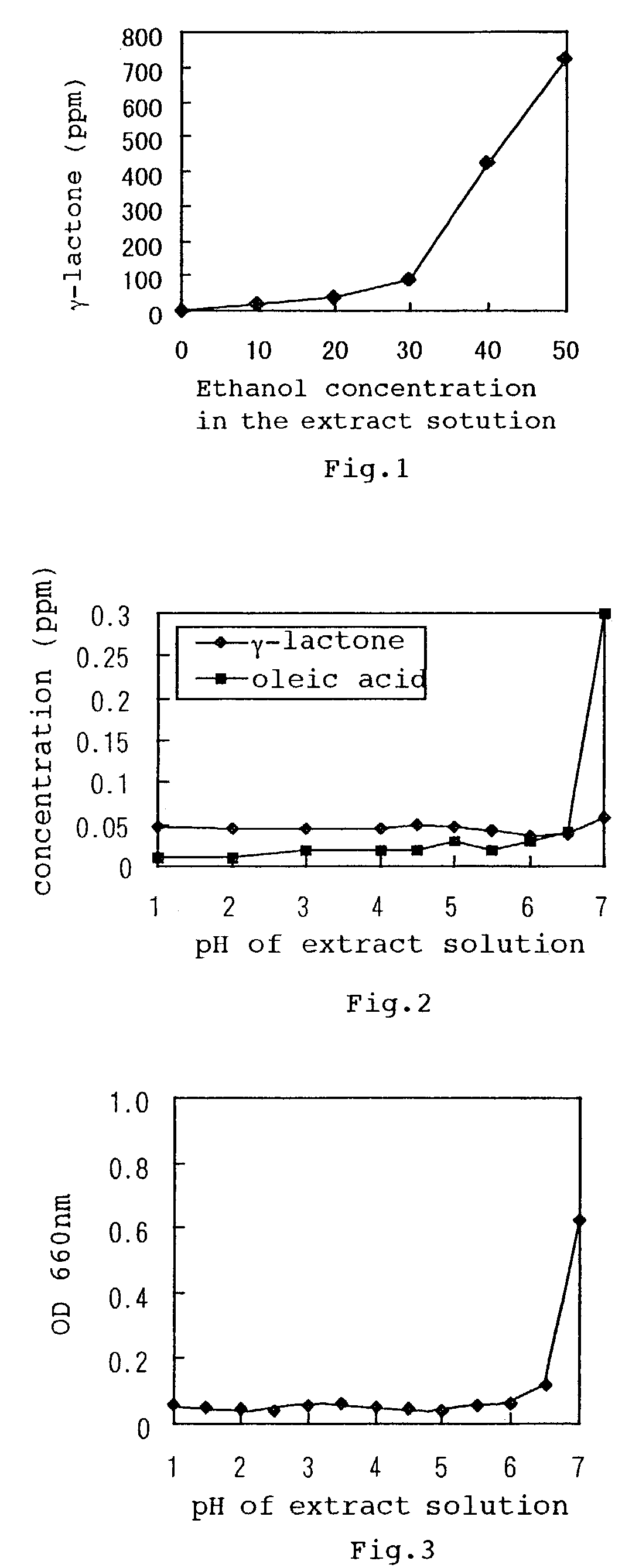Process for producing a bran pickles flavoring solution
a technology for bran pickles and flavoring solutions, applied in the field of flavoring solutions, can solve the problems of not having an industrial process for producing bran pickles flavoring solutions containing such compounds, and it is difficult to obtain desirable bran pickles flavoring solutions, etc., to achieve the effect of excellent flavor of bran pickles
- Summary
- Abstract
- Description
- Claims
- Application Information
AI Technical Summary
Benefits of technology
Problems solved by technology
Method used
Image
Examples
example 1
[0188]A dispersed solution prepared by mixing rice bran (Tajimaya) with water at a concentration of 10% (referred to as a 10% bran suspension) was heated to 85° C. and then cooled to 50° C. To the bran suspension were added protease (Novo Nordisk A / S), peptidase (Novo Nordisk A / S), amylase (Nagase Seikagaku Co., Ltd.), glucoamylase (Nagase Seikagaku Co., Ltd.) and lipase (Amano Pharmaceutical Co., Ltd.) which are suitable for use in food processing in an amount of 0.1% based on the rice bran, followed by reaction at 50° C. for 3 hours. After the reaction was completed, the reaction mixture was sterilized by heating at 120° C. for 15 minutes. Lactobacillus plantarum was inoculated therein as a lactic acid bacterium, followed by stationary culture at 25° C. for 2 days. Then, Saccharomyces cerevisiae was inoculated therein as a γ-DD lactone-producing yeast, followed by spinner culture under aeration at 25° C. for 4 days. After the culturing was completed, fermented lactic acid (90% lac...
example 2
[0194]After a 10% bran suspension was treated with enzymes and sterilized by heating in the same manner as in Example 1, Enterococcus faecalis was inoculated therein as a lactic acid bacterium, followed by stationary culture at 25° C. for 2 days. After the culturing was completed, the obtained culture was divided into two equal portions. Into one portion was inoculated Zygosaccharomyces bailii as a γ-DD lactone-producing yeast, followed by spinner culture under aeration for 5 days. Into the other portion was inoculated Propionibacterium freudenreichii as a propionic acid-producing bacterium, followed by stationary culture for 5 days. After the culturing was completed, both cultures were sterilized by heating at 95° C. for 30 minutes and sodium chloride was added thereto in an amount of 5%, followed by mixing of the cultures. The obtained mixture had a flavor of mature bran pickles and contained 1.2% propionic acid, 0.08% γ-dodecalactone and 0.09% γ-dodecelactone.
[0195]Cucumbers were...
example 3
[0199]After a 10% bran suspension was treated with enzymes and sterilized by heating in the same manner as in Example 1, Lactobacillus plantarum was inoculated therein as a lactic acid-producing bacterium, followed by stationary culture at 25° C. for 2 days. Further, Propionibacterium freudenreichii was inoculated therein as a propionic acid-producing bacterium, followed by stationary culture at 25° C. for 7 days. Separately, a 10% bran suspension was treated with enzymes and sterilized by heating in the same manner as in Example 1, and a γ-DD lactone-producing microorganism Corynebacterium sp. NK-1 was inoculated therein, followed by spinner culture under aeration for 5 days. After the culturing was completed, both cultures were mixed. The obtained mixture had a flavor of mature bran pickles and contained 0.7% propionic acid, 0.08% γ-dodecalactone and 0.06% γ-dodecelactone.
[0200]Cucumbers were pickled in an aqueous solution prepared by diluting said mixture 10 times (solution of th...
PUM
| Property | Measurement | Unit |
|---|---|---|
| vol % | aaaaa | aaaaa |
| temperature | aaaaa | aaaaa |
| pH | aaaaa | aaaaa |
Abstract
Description
Claims
Application Information
 Login to View More
Login to View More - R&D
- Intellectual Property
- Life Sciences
- Materials
- Tech Scout
- Unparalleled Data Quality
- Higher Quality Content
- 60% Fewer Hallucinations
Browse by: Latest US Patents, China's latest patents, Technical Efficacy Thesaurus, Application Domain, Technology Topic, Popular Technical Reports.
© 2025 PatSnap. All rights reserved.Legal|Privacy policy|Modern Slavery Act Transparency Statement|Sitemap|About US| Contact US: help@patsnap.com

